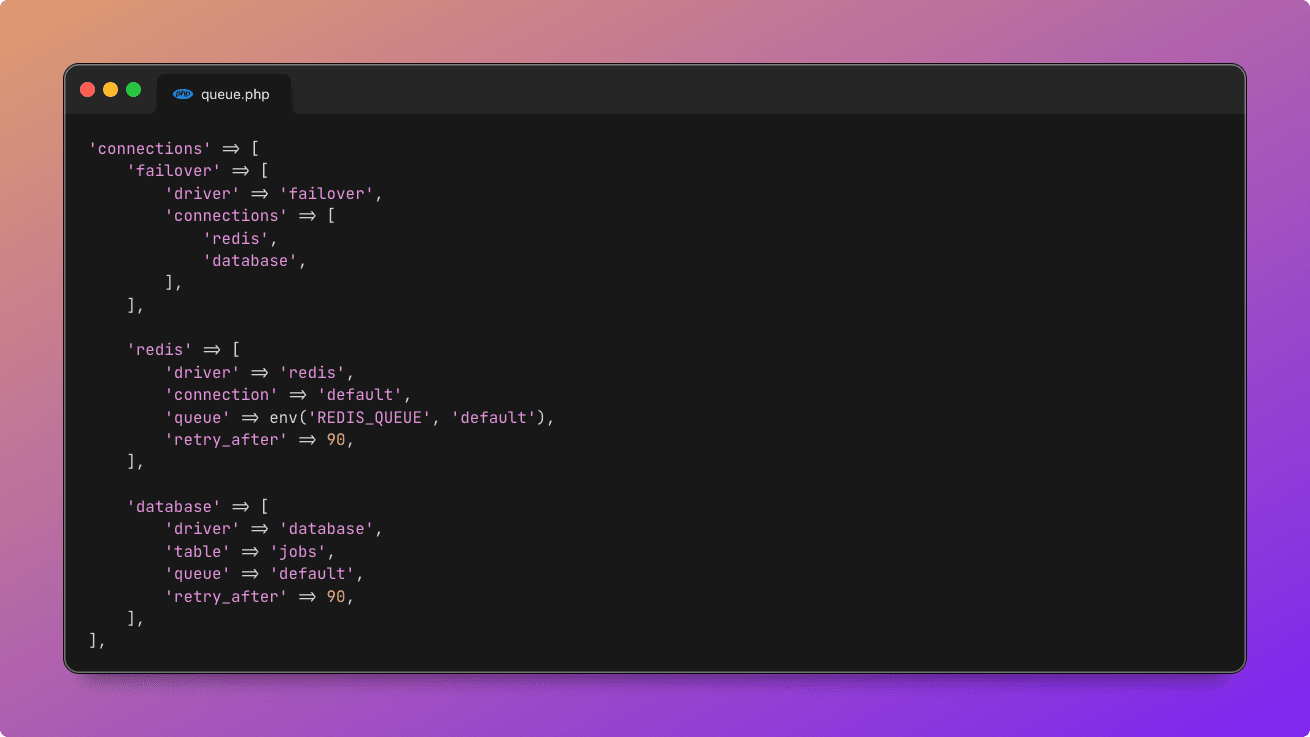Laravel 12.34 introduces a failover queue driver that dramatically improves the reliability of queued job processing. This new feature allows you to define multiple queue connections in order of priority, ensuring that your jobs are not lost even if the primary queue system fails.
In production environments, where uptime and consistent job delivery are critical, the failover driver can be a game-changer.
How the Failover Queue Driver Works
The failover driver acts as a wrapper around multiple queue connections. When a job is dispatched, Laravel will attempt to push it to the first connection in your list. If that connection fails — for example, if Redis is temporarily unavailable — Laravel automatically tries the next connection until the job is successfully queued.
This mechanism ensures high availability Laravel queues and protects your application from lost jobs or downtime.
Defining a Failover Queue Connection
You can configure the failover driver in your config/queue.php file. Here’s an example:
'connections' => [
'failover' => [
'driver' => 'failover',
'connections' => [
'redis',
'database',
],
],
'redis' => [
'driver' => 'redis',
'connection' => 'default',
'queue' => env('REDIS_QUEUE', 'default'),
'retry_after' => 90,
],
'database' => [
'driver' => 'database',
'table' => 'jobs',
'queue' => 'default',
'retry_after' => 90,
],
],In this setup:
Laravel will first try Redis to push jobs.
If Redis is unavailable, the system will fall back to the database queue, providing a job queue redundancy mechanism.
Setting the Default Queue Connection
Once your failover driver is configured, you can set it as the default queue connection in your .env file:
QUEUE_CONNECTION=failoverThis ensures that all queued jobs automatically use the failover logic, improving reliable job processing in Laravel.
When to Use the Failover Driver
The failover queue driver is ideal for:
Applications where job reliability is essential.
High-availability environments with multiple queue backends (Redis, SQS, Database).
Systems where downtime of one queue system should not interrupt job processing.
By using multiple connections, you ensure that your application can maintain continuous job dispatch even under failures.
Example: Dispatching Jobs With Failover
use App\Jobs\SendEmailJob;
SendEmailJob::dispatch($user)
->onConnection('failover');Laravel will automatically try to enqueue the job to Redis first. If Redis is down, it will failover to the database queue, ensuring no jobs are lost.
Benefits of the Failover Queue Driver
High reliability: Jobs are not lost if the primary queue fails.
Automatic fallback: Laravel seamlessly switches between connections.
Ease of configuration: Only a few lines in
queue.phpare needed.Production-ready: Ideal for applications that require robust job delivery.
Conclusion
Laravel’s failover queue driver ensures uninterrupted job dispatching by gracefully falling back to backup connections. This small configuration change significantly improves your application's queue system reliability, making it suitable for high-availability environments and critical job processing.
By implementing the failover driver, you gain a robust queue system that combines Redis speed with database reliability, ensuring continuous job delivery even during unexpected downtime.










